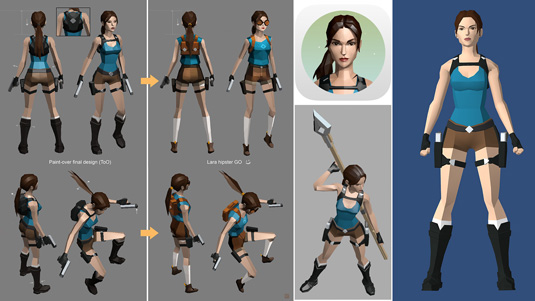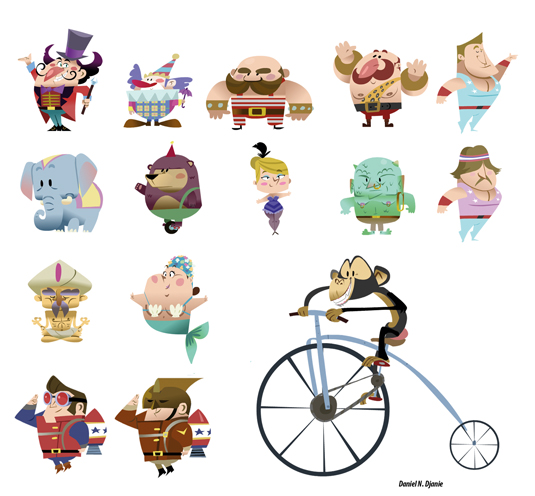How you could have a lucrative career in mobile gaming
High-end art for mobile is in demand – discover how to tap into this new world of portable gaming.

Think of mobile games and you might think of a bright, shiny fad like Bejeweled. But as devices get more powerful, they're actually getting closer to the quality of AAA games for the PlayStation 4 and XBox One.
And as mobile gaming becomes big business, the money's not just going to coders. Digital artists are getting a slice, too. So is this a potentially lucrative new market for your digital art skills?
Jack Gilson, lead artist at Wooga, starts by urging you to shed any preconceptions about mobile.
"It's one of the largest platforms for games right now," he says. "People who would never have usually played any type of video game, such as grandmothers, are now doing so."
Even free games are becoming cash cows, by charging for add-ons and access to extra levels. And so artists are increasingly in demand.

"Companies like Gameloft and Zynga are spending mega bucks on art teams," says Jack. "With most mobile companies now, the team sizes are getting way bigger, as art quality needs to excel to stand out."
Take Gameduell, where Daniel Nikoi Djanie is working as head of illustration. "Despite having been in the business for more than 10 years, we're currently reinventing ourselves – and one major part of this change is a strong focus on high-quality artwork," he says.
Daily design news, reviews, how-tos and more, as picked by the editors.
"Our team is continuously growing: at the moment we're 20 people led by Rockstar’s former art director Ian Bowden and myself."

And we're not just talking about the work of 3D artists. "2D will always have a place in mobile games, because although more games are becoming rendered sprites, they're essentially all hand-sketched first and then made in a 3D software package," explains Jack. "Concept artists will always be needed."
Square Enix's GO franchises have turned major console characters into successful small screen puzzle games, using 3D animation that goes far beyond the original console counterparts.

When the Montreal studio decided to move from AAA games to the mobile market, Lara Croft: GO Art Director, Thierry Doizon says it "definitely affected the whole production pipeline and the way we approach the creative process.
"The constraints of the mobile devices are improving a lot but are still very heavy (size, power, OS, touch…etc.), we have a lot of limitations in comparison to the current PC or console hardware."
However, he says that this forces them to experiment and try new things and keep in mind the mobile audience is broad, so visuals and game mechanics must attract pretty much everyone, not just the stereotypical hardcore gamer.
Artistic expression

While 3D artists on the whole are better paid than 2D artists, Daniel believes the latter role can be more rewarding creatively. "Being a 2D artist myself, I feel that I have more possibilities in this area for artistic expression," he explains, "because the individual artistic identity is more secondary and exchangeable in 3D artwork."
With mobile companies, team sizes are getting bigger as art quality needs to excel to stand out
Donald Mustard, creative director of Chair Entertainment – the company behind landmark iOS game Infinity Blade – also stresses the possibilities for creative expression.
"Modern devices are very powerful and so artists can now more fully realise their visions and ideas than ever before," he says. "We're now seeing huge diversity in the art direction of different games, from retro to realistic, and everything in between.

Of course, not every mobile game demands high-end art. “The degree of visual splendour depends entirely on the tone and point of the game you’re designing," says Barry Meade, co-founder of Fireproof Studios.
"Many titles are successful because of their game mechanics or player involvement or whatever, and aren't art heavy or visually focused – Minecraft being an obvious example.
But in specific cases, like our game The Room, the game wouldn't be the same if we didn't go all out to create as fabulous looking a world as possible. Generally, you can think of great art as a multiplier: it helps to sell things, but without other aspects in place to work with it makes little impact."

With Lara Croft GO, the team at Square Enix went retro, with mid-range graphics, taking inspiration from the first Tomb Raider games.
The result is a visual style not far removed from an AAA console game released less than a decade ago, alongside great game-play.
Focusing on how Lara is depicted in the 90's trilogy, "We really wanted to go back to the Lara Croft we knew from our childhood. The first Tomb Raider games were some of the team's first experience with 3D games back in the day and that sense of discovery was something we wanted to pursue."

The team were able to take a nostaligic approach and recreate the low poly look of the original games - using it as a "creative constraint" rather than the technical constraint it had been with the original series, this "constraint", however, meant that some original and unique creative aesthetics could be developed.
"Finalizing the art direction was a huge challenge, to be honest it took us a long time to define the world that you see now. Making things look simple is actually pretty hard!"

"As you can see we have created something truly original for a Tomb Raider/Lara Croft episode, the art direction really fits well with the screen format and the gamers seem to respond very positively to it," says Thierry.
"Even though we have different visions within the many studios at Square-Enix and Eidos when it comes to visual development, Crystal Dynamics supported us all along the project.
"We had to make something original to really stand out from the competition. The great thing about Square-Enix Montreal is that we have no other options, we need to rely on artistic freedom to create those games. "
A bigger cog in the machine

Right now, mobile art teams are relatively small. "This means as an artist you're a bigger cog in the machine," says Jack.
"Your work is more visible: a lot falls down to you and you also need to be multi-talented. If you want to do more on an art team and have smaller game production cycles, then mobile is a fantastic choice."
In comparison, Jack says a console games role means you'll probably "work longer hours and not make as much as an impact until you're at a senior level."
If you want to do more art and have smaller game production cycles, then mobile is a fantastic choice
Of course, there's a flipside to all this. The days when mobile was an easy way into the games industry for the newbie artist are well and truly over. For example, Fireproof mainly recruits experienced artists from AAA companies such as EA/Criterion, says Barry.
For Gameduell, meanwhile: "Either you should be a generalist able to combine artistic abilities, technical understanding and a sense for the user experience, or you're a specialist who's outstanding in their artistic field," says Daniel.

Wooga, similarly, is looking for the same level of skill and qualifications as if you were applying to one of the big AAA companies, says Jack, adding: "We lean towards the more stylised art style, so coming from a background in cartoons and animations helps greatly."
But it's not all bad news for up-and-coming artists: "Juniors and interns are still invited to join mobile games companies," Jack says. "In fact, some juniors these days know more than some of the old seniors."
And with teams in mobile gaming being smaller, such a role offers greater challenges but also, potentially, greater opportunities. Or as he puts it, "You can learn more in mobile – but you need to come in hard and be fast at what you do."
This is an extended version of an article originally appeared in ImagineFX magazine issue 127.
Like this? Read these...
- How to draw and paint - 90 pro tips and tutorials
- 13 inspirational comic artists to follow on Instagram
- Is the new Corel Painter worth investing in?

The Creative Bloq team is made up of a group of art and design enthusiasts, and has changed and evolved since Creative Bloq began back in 2012. The current website team consists of eight full-time members of staff: Editor Georgia Coggan, Deputy Editor Rosie Hilder, Ecommerce Editor Beren Neale, Senior News Editor Daniel Piper, Editor, Digital Art and 3D Ian Dean, Tech Reviews Editor Erlingur Einarsson, Ecommerce Writer Beth Nicholls and Staff Writer Natalie Fear, as well as a roster of freelancers from around the world. The ImagineFX magazine team also pitch in, ensuring that content from leading digital art publication ImagineFX is represented on Creative Bloq.
